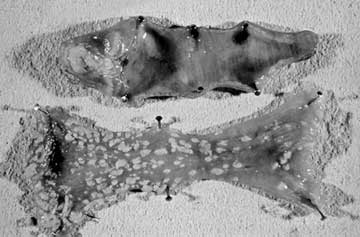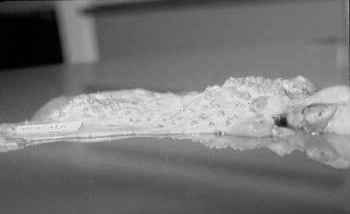| | Life cycle and transmission of T. gallinae | How are birds harmed by T. gallinae? | How to know when birds are infected | How to if birds are infected with T. gallinae | How to prevent birds from getting Trichomoniasis | How to treat infected birds
The protozoan Trichomonas gallinae is a cosmopolitan parasite of pigeons and doves. Other birds such as domestic and wild turkeys, chickens, raptors (hawks, golden eagle, etc.) may also become infected. The disease in pigeons is commonly called "canker". A similar condition in falcons is called "frounce."
Life Cycle and Transmission of T. gallinae
T. gallinae is generally found in the oral-nasal cavity or anterior end of the digestive and respiratory tracts. The trichomonads multiply rapidly by simple division (binary fission), but do not form a resistant cyst. They therefore die quickly when passed out of the host.
Because of the nature of the life cycle, transmission of the parasite from one bird to another occurs in one of three ways. In pigeons, transmission occurs when infected older birds (carriers) feed "pigeon milk" to newly hatched squabs. Adult birds, which do not show signs of disease, may carry the infection for a year or more and are a constant source of infection for their young.
Turkeys and chickens likely become infected through contaminated drinking water or food. Because the trichomonads do not survive for long outside the bird, transmission must occur rapidly. Wild pigeons and other birds may be an important source of introducing the infection to domestic birds.
The third method of transmission is more common to birds of prey. An infection may be established in a raptor that has fed on an infected prey bird.
How are Birds Harmed by T. gallinae?
Avian trichomoniasis is principally a disease of young birds. The severity of the disease depends on the susceptibility of the bird and on the pathogenic potential of the strain of the parasite. Adult birds that recover from the infection may still carry the parasite, but are resistant to reinfection. These birds do not show obvious signs of infection.
In young birds, the early lesions appear as small white to yellowish areas in the mouth cavity, especially the soft palate (Figure 1). The lesions consist of inflammation and ulceration of the mucosal surface. The lesions increase in size and number and extend to the esophagus, crop and proventriculus (Figure 2). The lesions may develop into large, firm necrotic masses that may block the lumen. Occasionally, the disease may spread by penetrating the underlying tissues to involve the liver and other organs.

Figure 1. Trichomoniasis in the esophagus and
larynx of a chicken

Figure 2. Trichomoniasis in the crop of a turkey |
How to Know When Birds are Infected
In acute cases, there may be little indication that the bird is infected, and death may occur quite suddenly. In other cases, infected pigeon squabs may stop feeding, lose weight, look ruffled and dull, and be unable to stand or maintain their balance.
Diarrhea may also occur. Death may occur within three weeks of infection. Greenish fluid or cheesy material may accumulate in the mouth and crop, and this material may exude from the beak. A pendulous crop may develop in turkey poults and chickens.
How to Know if Birds are Infected with T. gallinae
Characteristic yellowish-white nodules in the oral cavity, esophagus and crop strongly suggest trichomoniasis. The infection is confirmed by finding the organism during microscopic examination of the greenish fluids, cheesy material or the lesion.
How to Prevent Birds from Getting Trichomoniasis
Trichomoniasis can be controlled in a flock by culling or treating carrier birds. Food and water sources should be cleaned regularly and protected from contamination by wild pigeons and other birds.
How to treat Infected Birds
Antiprotozoal medications, such as dimetridazole and metronidazole, are used to treat birds infected with T. gallinae. Contact your veterinarian for advice on the most suitable drug and treatment program.
Prepared by:
Dr. Murray J. Kennedy , Food Safety Division
Alberta Agriculture and Food
Source: Agdex 663-34. Revised April 2001. |
|